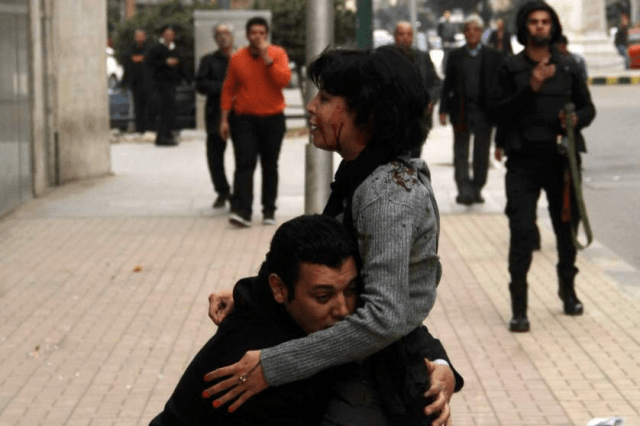Protesting is a dicey business in Egypt, which has been through three governing regimes in four years. The current regime passed a strict law to control street protests in 2013, but last January it was violated by a demonstration that was eventually dispersed by police, resulting in the death of protester Shaimaa Sabbagh.
Sabbagh was apparently shot by accident in the confusion and died on the street while video cameras were rolling:
Reuters reports that an Egyptian court has acquitted 17 people for violating the protest law during this demonstration, the first acquittals since the law went into effect. Some say the move is a peace offering to the opposition, an effort by the government of President Abdel Fattah al-Sisi to soften its image.
Lawyer Sayed Abu el-Ila — seen in the video clip above with Shaimaa Sabbagh dying in his arms — appears skeptical of this claim. “I am not pleased by an acquittal at the expense of Shaimaa’s blood,” he said. “Shaimaa sacrificed her life to oppose an unjust law, and the law is still in place.”
Photographer Islam Osama, who was standing near Sabbagh when she was shot and captured her final moments with his camera, told Time the demonstration in which she died was a small gathering in Cairo’s famed Tahrir Square, consisting of only about 25 people, and it went on for only two minutes before the police began firing tear gas and birdshot.
As soon as he realized what he had just photographed, Osama feared for his own safety. “I realized immediately that I had to leave,” he said. “I had to send the photos to the newspaper, fast. If I waited a moment too long there was a chance that my camera could be taken and the memory card erased by the police.”
Egyptian opposition groups and human-rights activists were not amused when the government’s medical examiner declared in March that Sabbagh died from relatively minor wounds because she was too thin. “Her body was like skin over bone, as they say,” a spokesman for the Medical Forensics Authority explained. “She was very thin. She did not have any percentage of fat. So the small pellets penetrated very easily, and four or five out of all the pellets that penetrated her body – these four or five pellets were able to penetrate her heart and lungs, and these are the ones that caused her death.”
As for the police officer who fired the fatal shotgun blast, he was charged with the equivalent of manslaughter at the same time the now-dropped charges of violating the protest law were leveled at many of Sabbagh’s fellow demonstrators. At the time, Human Rights Watch noted that the officer in question was facing roughly the same potential prison sentence as the protesters were. Judging by this weekend’s Reuters report, the charges against the officer are still pending.

COMMENTS
Please let us know if you're having issues with commenting.